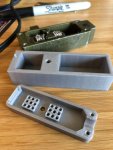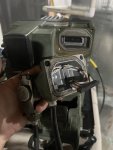aleigh
Well-known member
- 1,040
- 53
- 48
- Location
- Phoenix, AZ & Seattle, WA
For awhile now I've had a back-burner project to get a military radio setup working in my LMTV. The first phase of that was getting a VIC-3 system installed, which I mated to a Yaesu FT-857 by making a cable. I have all that mounted in one of the equipment racks that go behind the passenger seat. What I've really wanted to get working is a VAA with a removable PRC-152.
I happen to have two PRC-152 radios, so it was pretty straight-forward to purchase a VAA, they are on ebay and other places. What is harder is to find the mounting tray that has the intercom outputs; not all mounting trays do, and I think those were for fixed-station operation, like in the hardigg shock cases you see come up for sale from time to time.
In anticipation of someone getting twisted up about the PRC-152s, a bit of history. Harris developed the PRC-152 and a manpack radio on-spec (not for a contract) in the hopes they could sell them to various militaries, which became known as the Falcon II radios. This family has commercial encryption but it is non-CCI, non-Type1. The US bought a lot of them but decided that they needed a radio family which was SINCGARS compatible and usable for TS traffic. So, Harris produced the Falcon III, a Type-1, CCI controlled radio family. Since the F3 is CCI it has all the attendant legal/ownership issues. The F2 radios are commercial, off the shelf, and are legal, just rare.
When my VAA arrived I went to get it going and imagine my surprise to discover that the side connector (carrying the intercom lines, and PTT) was 32-pin instead of 18-pin. It turns out that the F2 family took the edge connector from the PRC-148 MBITR with a different pinout (and different key) and the F3 family uses a 32-pin edge connector. The VAA I had purchased was apparently a F3 VAA.
I sort of stupidly assumed that it was basically a broadband linear amplifier and so if I hooked up the antenna from the radio to the amp, it would work, and I would be missing the audio/ptt. I was wrong, the VAA did not work at all in this configuration. No rx, no tx. But it did draw about 25W at idle. I thought the amp might be broken so I took it all apart. Internally, it consists of a power supply, a motherboard with a Freescale microcontroller and a Spartan FPGA, and two RF boards. The amplifier and filter array looks like it's directly controlled by the computer. So, not simple. Around this time I also noticed that when I docked a radio it was saying "Connecting to VAA". So somehow from the battery pins it is able to deduce it's docked with a VAA.
To make a long story short, the radio interfaces with the amp, and by some miracle, the F2 firmware on the radio is willing to talk to the F3 amplifier that was produced many years later. The connection is established over the 2-wire RS-232 connection on the radio used for the remote control (the KDU). I used an o-scope to chase down all the pins. As soon as those were jumped between the VAA and the Radio it established a link, rx came alive, and it began working. If you interrupt the link during operation the radio displays a VAA fault.
There are some take-aways from this. The first is: Falcon 3 VAAs can be used with older Falcon 2 radios. The second is that they can ONLY be used with Harris radios. Anybody's hopes of getting a TRI radio or a random Ham radio to take advantage of these wideband 50W amps can probably stop right now. That said, I suppose it might be possible to decode the RS-232 and try to figure out what is going on between the VAA and the Radio. My guess is they handshake and then the radio passes the frequency information (keeping in mind they are frequency hopping) but that's a total guess. It might be possible to jerry rig an arduino or something to pretend to be the radio, but at that point, I am not sure it's a productive use of time just to get a 50W amp. Someone wanting that kind of a solution should take a look at Ultralife, they make broadband vehicle amps for these radios which do not appear to need a data-link or software-level support.
Draws well over 100W on TX.
For my part, I need to order or 3d-print a 18 pin connector, and then get my audio, ptt, and rs-232 lines wired up and it should be good to go in the truck.
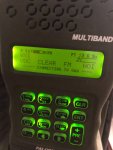
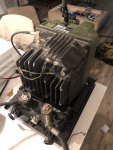
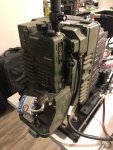
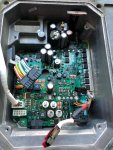
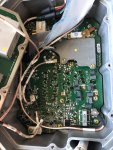
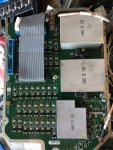
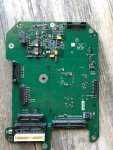
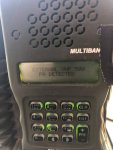
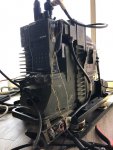
I happen to have two PRC-152 radios, so it was pretty straight-forward to purchase a VAA, they are on ebay and other places. What is harder is to find the mounting tray that has the intercom outputs; not all mounting trays do, and I think those were for fixed-station operation, like in the hardigg shock cases you see come up for sale from time to time.
In anticipation of someone getting twisted up about the PRC-152s, a bit of history. Harris developed the PRC-152 and a manpack radio on-spec (not for a contract) in the hopes they could sell them to various militaries, which became known as the Falcon II radios. This family has commercial encryption but it is non-CCI, non-Type1. The US bought a lot of them but decided that they needed a radio family which was SINCGARS compatible and usable for TS traffic. So, Harris produced the Falcon III, a Type-1, CCI controlled radio family. Since the F3 is CCI it has all the attendant legal/ownership issues. The F2 radios are commercial, off the shelf, and are legal, just rare.
When my VAA arrived I went to get it going and imagine my surprise to discover that the side connector (carrying the intercom lines, and PTT) was 32-pin instead of 18-pin. It turns out that the F2 family took the edge connector from the PRC-148 MBITR with a different pinout (and different key) and the F3 family uses a 32-pin edge connector. The VAA I had purchased was apparently a F3 VAA.
I sort of stupidly assumed that it was basically a broadband linear amplifier and so if I hooked up the antenna from the radio to the amp, it would work, and I would be missing the audio/ptt. I was wrong, the VAA did not work at all in this configuration. No rx, no tx. But it did draw about 25W at idle. I thought the amp might be broken so I took it all apart. Internally, it consists of a power supply, a motherboard with a Freescale microcontroller and a Spartan FPGA, and two RF boards. The amplifier and filter array looks like it's directly controlled by the computer. So, not simple. Around this time I also noticed that when I docked a radio it was saying "Connecting to VAA". So somehow from the battery pins it is able to deduce it's docked with a VAA.
To make a long story short, the radio interfaces with the amp, and by some miracle, the F2 firmware on the radio is willing to talk to the F3 amplifier that was produced many years later. The connection is established over the 2-wire RS-232 connection on the radio used for the remote control (the KDU). I used an o-scope to chase down all the pins. As soon as those were jumped between the VAA and the Radio it established a link, rx came alive, and it began working. If you interrupt the link during operation the radio displays a VAA fault.
There are some take-aways from this. The first is: Falcon 3 VAAs can be used with older Falcon 2 radios. The second is that they can ONLY be used with Harris radios. Anybody's hopes of getting a TRI radio or a random Ham radio to take advantage of these wideband 50W amps can probably stop right now. That said, I suppose it might be possible to decode the RS-232 and try to figure out what is going on between the VAA and the Radio. My guess is they handshake and then the radio passes the frequency information (keeping in mind they are frequency hopping) but that's a total guess. It might be possible to jerry rig an arduino or something to pretend to be the radio, but at that point, I am not sure it's a productive use of time just to get a 50W amp. Someone wanting that kind of a solution should take a look at Ultralife, they make broadband vehicle amps for these radios which do not appear to need a data-link or software-level support.
Draws well over 100W on TX.
For my part, I need to order or 3d-print a 18 pin connector, and then get my audio, ptt, and rs-232 lines wired up and it should be good to go in the truck.









Last edited:



